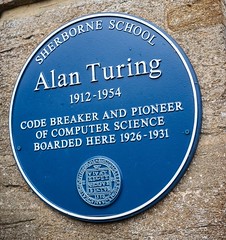Alan Turing


Alan Turing
(1912-1954)
code-breaker, pioneer of computer science, founder of computer science, cryptographer, creator of computer science, mathematician, and Reader in Mathematics (1948-1954)
designer of The Bombe
Commemorated on 14 plaques
Alan Turing 1912-1954 code-breaker and pioneer of computer science was born here
2 Warrington Cresent, Maida Vale, Westminster, W9, London, United Kingdom where they was born (1912)
Alan Turing 1912-1954 code breaker lived here from 1945-1947
78 High Street, Hampton, London, United Kingdom where they lived
Alan Turing 1912-1954 founder of computer science and cryptographer, whose work was key to breaking the wartime Enigma codes, lived and died here.
43 Adlington Road, Wilmslow, United Kingdom where they lived and died (1954)
The family home of Alan M. Turing (1912-1954) founder of computer science
22 Ennismore Avenue, Guildford, United Kingdom where they lived
Engineering Heritage Award The Bombe Bletchley Park Completed in 2007 using the original blueprints. An electromechanical device designed by A Turing, G Welchman and H Keen, used in cracking the German Enigma code during the Second World War. The 200 Bombes built by the British Tabulating Machine Company played a pivotal role in winning the war.
Block B - Bletchley Park , Bletchley, United Kingdom where they designed The Bombe
The Turing Bombe Rebuild Project Presented to John Harper MBCS, Chairman, Turing Bombe Rebuild Project Team, BCS Computer Conservation Society by John L Ivinson FBCS, President. In recognition of the outstanding work undertaken by the team. Presented at the BCS Specialist Groups Assembly, Bletchley Park 9th April 2003
Block B - Bletchley Park, Bletchley, United Kingdom where they originally designed
IEEE Milestone in Electrical Engineering and Computing Code-breaking at Bletchley Park during World War II, 1939-45. On this site during the 1939-45 World War, 12,000 men and women broke the German Lorenz and Enigma ciphers, as well as Japanese and Italian codes and ciphers. They used innovative mathematical analysis and were assisted by two computing machines developed here by teams led by Alan Turing: the electro-mathematical Bombe developed with Gordon Welchman, and the electronic Colossus designed by Tommy Flowers. These achievements greatly shortened the war, thereby saving countless lives.
Bletchley Park House, Bletchley Park, Bletchley, United Kingdom where they code-breaking assisted by two computing machines developed here by teams led by (1939-1945)
Alan Mathison Turing 1912-1954 a creator of computer science, code breaker and mathematician. Reader in Mathematics 1948-1954
Coupland Building 1, Coupland Street, M13 9PL, Manchester, United Kingdom where they was Reader in Mathematics (1948-1954)
Alan Turing 1912 - 1954 mathematician, computer pioneer and code breaker
St Catherine's College Library - St Catherine's College - Trumpington Street, Cambridge, United Kingdom where they was
Alan Turing 1912-1954 founder of computer science and cryptographer, whose work was key to breaking the wartime Enigma codes, spent his childhood here.
Baston Lodge, 1 Upper Maze Hill, St Leonards-On-Sea, TN38 0LA, Hastings, United Kingdom where they lived
Alan Mathison Turing 1912-1954 A Creator of Computer Science, Code Breaker and Mathematician Reader in Mathematics 1948-1954
Coupland Street, Manchester, United Kingdom where they was
Alan Turing 1912-1954 code breaker and pioneer of computer science boarded here 1926-1931
Westcott House on Horsecastles, Sherborne, United Kingdom where they was
Alan Turing Code Breaker & Pioneer of Computer Science Love Lived Here 1912-1954
2 Warrington Crescent, London, United Kingdom where they lived (1912-1954)
White Cottage home to Alan Turing, Alan Hinsley, John Tiltman wartime codebreakers 1939-1946
Hanmer Road, Simpson, United Kingdom where they stayed

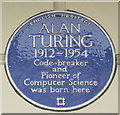


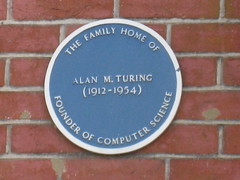
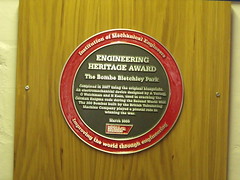
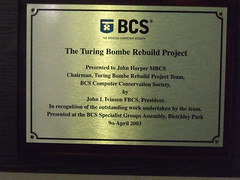
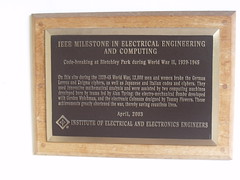
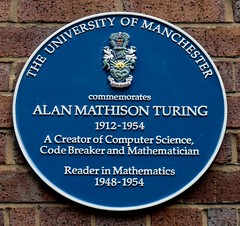
.jpg?width=250)


